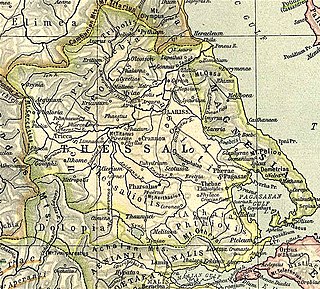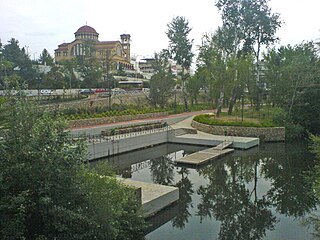
Ionia was an ancient region on the central part of the western coast of Anatolia in present-day Turkey, the region nearest İzmir, which was historically Smyrna. It consisted of the northernmost territories of the Ionian League of Greek settlements. Never a unified state, it was named after the Ionian tribe who, in the Archaic Period, settled mainly the shores and islands of the Aegean Sea. Ionian states were identified by tradition and by their use of Eastern Greek.

Caria was a region of western Anatolia extending along the coast from mid-Ionia (Mycale) south to Lycia and east to Phrygia. The Ionian and Dorian Greeks colonized the west of it and joined the Carian population in forming Greek-dominated states there. The inhabitants of Caria, known as Carians, had arrived there before the Ionian and Dorian Greeks. They were described by Herodotus as being of Minoan Greek descent, while the Carians themselves maintained that they were Anatolian mainlanders intensely engaged in seafaring and were akin to the Mysians and the Lydians. The Carians did speak an Anatolian language, known as Carian, which does not necessarily reflect their geographic origin, as Anatolian once may have been widespread. Also closely associated with the Carians were the Leleges, which could be an earlier name for Carians or for a people who had preceded them in the region and continued to exist as part of their society in a reputedly second-class status.
Heraclea, Heracleia, Herakleia, or Heraclia may refer to:
Kyllini, Cyllene or Kyllene may refer to:
Neapoli or Neapolis may refer to:
Argos is a city in Argolis, Peloponnese, Greece.
Nicaea or Nikaia may refer to :
Charax (Χάραξ) may refer to:
Panormos or Panormus, meaning "sheltered harbor", may refer to:
In Greek mythology, Pyrrha was the daughter of Epimetheus and Pandora.

Pelasgiotis was an elongated district of ancient Thessaly, extending from the Vale of Tempe in the north to the city of Pherae in the south. The Pelasgiotis included the following localities: Argos Pelasgikon, Argyra, Armenium, Atrax, Crannon, Cynoscephalae, Elateia, Gyrton, Mopsion, Larissa, Kondaia, Onchestos river and town, Phayttos, Pherae, Scotussa, and Sykourion. The demonym of the district's inhabitants is Pelasgiotae or Pelasgiotes.
Larissa was an ancient Greek city located in Thrace, located in the region between the river Nestos to the river Hebros. Larissa was located in the borderland between Elis and Achaian Dyme. It remains unlocated and unidentified.

The regions of ancient Greece were areas identified by the ancient Greeks as geographical sub-divisions of the Hellenic world. These regions are described in the works of ancient historians and geographers, and in the legends and myths of the ancient Greeks.
The following is a list of regions of Ancient Anatolia, also known as "Asia Minor," in the present day Anatolia region of Turkey in Western Asia.

Larisa, or Larissa, was an ancient Greek city in the south-west of the Troad region of Anatolia. Its surrounding territory was known in Greek as the Λαρισαῖα (Larisaia). It has been located on a small rise by the coast now known as Limantepe, about 3.5 km from the village of Kösedere to the north-east and 3 km from the village of Babadere to the east, in the Ayvacık district of Çanakkale province, Turkey. As with other Greek toponyms containing the consonantal string -ss-, spellings that drop one 's' exist alongside those that retain both in the ancient literary sources. Larisa in the Troad should not be confused with 'Aeolian' Larisa, near Menemen, or with 'Ionian' Larisa in İzmir province.

The prehistory of Anatolia stretches from the Paleolithic era through to the appearance of classical civilisation in the middle of the 1st millennium BC. It is generally regarded as being divided into three ages reflecting the dominant materials used for the making of domestic implements and weapons: Stone Age, Bronze Age and Iron Age. The term Copper Age (Chalcolithic) is used to denote the period straddling the stone and Bronze Ages.
Chryse is a name occurring in Ancient Greek geography, reported by ancient authors to have referred to the following places:
Chalcis is a city on the Euripus Strait between the island of Euboea and the Greek mainland.
This page is based on this
Wikipedia article Text is available under the
CC BY-SA 4.0 license; additional terms may apply.
Images, videos and audio are available under their respective licenses.










